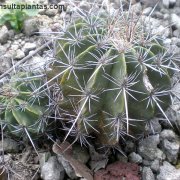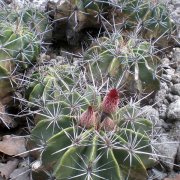Care of the cactus Ferocactus flavovirens or Echinocactus flavovirens |
|
The genus Ferocactus, family Cactaceae, comprises 30 species of large cacti native to Mexico and the southwestern United States. Some species are: Ferocactus flavovirens, Ferocactus cylindraceus, Ferocactus alamosanus, Ferocactus histrix, Ferocactus latispinus, Ferocactus schwarzii, Ferocactus hamatacanthus, Ferocactus emoryi, Ferocactus x californicus, Ferocactus viridescens, Ferocactus gracilis, Ferocactus glaucescens, Ferocactus stainesii, Ferocactus peninsulae, Ferocactus robustus, Ferocactus wislizenii. Scientific synonyms: Echinocactus flavovirens, Parrycactus flavovirens, Bisnaga flavovirens. This species is native to Mexico. They are cacti with a slightly elongated spherical bearing and flattened at the apex that branch out from the base, forming colonies; they reach 40 cm (15.74") in height and 20 cm (7.87") in diameter. They have 13 sharp ribs with oval areoles with 14 thin radial spines and 4 central spines. The flowers are yellow and orange and are funnel-shaped. They bloom in summer. Echinocactus flavovirens is used in rockeries, on dry slopes, in cactus and succulent gardens, and in pots for patios, terraces, and greenhouses. Ferocactus flavovirens needs direct sun exposure and high temperatures. It's better that the winter temperature is not lower than 5 ºC (41 ºF). The soil can be a mixture, in the same proportions, of coarse siliceous sand and leaf mulch. It's important not to water in winter; the rest of the year water very moderately, always waiting for the substrate to dry. Bisnaga flavovirens is an easy to grow plant that do not needs pruning or fertilizers. Ferocactus flavovirens is avery sensitive plant to excess humidity. Parrycactus flavovirens propagates easily by stem cuttings or by seeds sown in spring. |
Images of the cactus Ferocactus flavovirens or Echinocactus flavovirens |
Find plants
Ferocactus flavovirens or Echinocactus flavovirens | Care and Growing
© 2026 FavThemes

